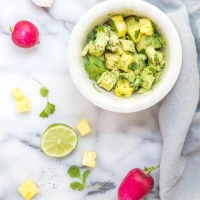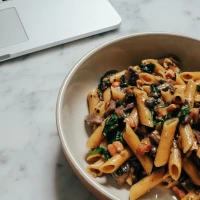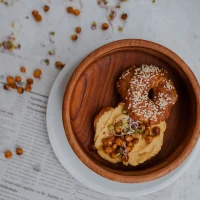Pasta, a staple in many cultures, is more than just a source of comfort food; it’s a culinary canvas begging for personalization. Whether you twirl, fork, or spoon your way through a steamy bowl, pasta offers a satisfying base for a multitude of flavors and ingredients. However, crafting a bowl of pasta that is not only delicious but also aligns with your health and wellness goals can seem like a daunting task. With the right guidance, you can create the perfect bowl of pasta that is both waistline-friendly and packed with nutrients. Let’s delve into the art of making a calories-wise pasta dish that supports healthy eating without compromising taste.
Understanding the Pasta Bowl: Calories Matter
The foundation of any pasta dish – the noodles themselves – are often subject to scrutiny for their calorie content. While it’s true that pasta contains calories, understanding the role they play in your diet is crucial.
The Caloric Content of Pasta
Pasta is primarily composed of carbohydrates, which are essential macronutrients that your body utilizes for energy. On average, a standard serving of cooked pasta (about 2 ounces of dry pasta) contains 200 calories. However, it’s easy to go overboard without realizing it, which can lead to unintentional calorie surplus.
Choosing the Right Pasta
- Whole grain pasta: A healthier option that retains all parts of the grain, offering a richer nutrient profile, including fiber.
- Legume-based pasta: Options such as chickpea, lentil, or black bean pasta are high in protein and fiber, contributing to a lower-calorie bowl.
- Vegetable-infused pasta: These contain added vegetable purees, enhancing the nutrient content and often reducing the calorie density.
Portion Control with Your Pasta
Determining the right portion size is paramount when creating a low-calorie pasta experience. Visual cues, like comparing a serving size to the size of your fist, can aid in preventing overindulgence.
Elevating Nutrition with Pasta Add-Ins
A well-balanced pasta bowl is about more than just the noodles. It’s the combination of ingredients that help transform your pasta into a meal that is both nutritious and satisfying.
Prioritizing Protein
Incorporating lean proteins into your pasta bowl ensures a more rounded nutritional profile. Consider options such as:
- Grilled chicken: A versatile, low-fat source of protein.
- Seafood: Shrimp or scallops, which are high in protein but low in calories.
- Tofu: A plant-based protein that absorbs flavors beautifully.
Amping Up the Veggies
Vegetables are nutrient-dense and high in fiber while being low in calories, making them perfect for bulking up your pasta.
- Spinach
- Broccoli
- Cherry tomatoes
- Zucchini
- Bell peppers
Healthy Fats for Flavor and Fullness
Using healthy fats judiciously can elevate the taste and texture of your pasta bowl while keeping it wholesome.
- Olive oil: A heart-healthy fat that is excellent for dressing and sautéing.
- Avocado: Provides creaminess along with beneficial monounsaturated fats.
- Nuts: Crushed almonds or pine nuts can offer a satisfying crunch.
Mastery of the Pasta Sauce
The sauce is where many calories can sneak into your pasta bowl. Opting for lighter versions or making your own ensures control over what goes into it.
Tomato-Based Sauces
A classic marinara or tomato basil sauce can be a flavorful, low-calorie choice. Look for versions without added sugar, or make your own with crushed tomatoes, herbs, and garlic.
Creamy, Yet Calorie-Conscious
Creating a creamy sauce doesn’t have to be a calorie bomb. Greek yogurt or blended silken tofu provides a rich base without the excess calories of heavy cream.
Veggie-Packed Pesto
Pesto can be dense in calories due to the oil and nuts. However, adding steamed greens like kale or spinach can increase the volume and nutrient value while reducing calorie load.
Homemade Dressing Swaps
Preparing your dressings at home can drastically cut back on hidden calories. A dash of lemon juice, vinegar, and spices can go a long way in adding pizzazz without the excess calories.
Balancing Flavors and Seasonings
A mastery of seasonings and herbs can significantly enhance the flavor profile of your pasta bowl without adding excess calories.
Herbs and Spices
Fresh herbs like basil, parsley, or cilantro not only contribute bursts of flavor but also pack a variety of health benefits. Spices such as chili flakes, black pepper, and oregano can strongly impact the taste sensation, eliminating the need for high-calorie additives.
The Role of Garlic and Onion
Both garlic and onion act as a fundamental base for flavor-building in most pasta dishes. They are also known for their health-promoting properties and are low in calories.
Leveraging Citrus Zest and Juices
The zest and juice of lemons or limes can instantly lift the flavors in your pasta bowl, providing a refreshing tanginess that pairs well with light ingredients.
Portioning Your Pasta: A Serving Size Guide
Understanding what constitutes a single serving of pasta is essential to calorie management. Typically, a recommended serving is about the size of your fist. Use measuring cups or a kitchen scale for precision.
Utilizing the Plate Method
The Plate Method is a visual guide that divides your plate into sections to encourage portion control and a balanced mix of food groups:
- One-half of the plate with vegetables
- One-quarter with lean protein
- One-quarter with whole-grain pasta
Mindful Eating Practices
Eating mindfully involves being present during your meals, taking the time to savor each bite, and listening to your hunger and fullness cues. This practice can prevent overeating and contribute to a more enjoyable and healthful dining experience.
The Impact of Cooking Methods on Calories
The way you cook your pasta and its accompaniments can significantly impact the calorie content of the final dish.
Boiling and Steaming
Boiling and steaming are the go-to methods for pasta and vegetables, as they do not require additional fats for cooking. These techniques preserve the natural flavors and nutrients in the ingredients.
Sautéing and Grilling
- Sautéing: When done correctly with minimal oil, sautéing can impart a layer of caramelization and depth to your ingredients without tacking on too many calories.
- Grilling: Infuses protein with smokiness and char, which can satiate without the need for calorie-rich sauces.
Avoiding Calorie-Dense Cooking Methods
Frying or cooking with creamy sauces exponentially increases the calorie count. Opt for grilling, baking, or steaming to keep your pasta bowl in a healthier calorie range.
Crafting Your Low-Calorie Pasta Bowl: The Assembly
Now that we’ve explored the components, it’s time to bring everything together into a harmonious, healthy pasta bowl.
Starting With the Pasta
Begin with your measured portion of cooked pasta, opting for whole-grain, legume-based, or vegetable-infused varieties for added nutritional value.
Layering in Protein and Vegetables
Add your choice of lean protein and a generous helping of colorful vegetables to ensure a myriad of textures, flavors, and nutrients.
Strategically Applying Sauce and Dressings
Use a light hand when adding sauce or dressings, and consider using a spoon to drizzle rather than pour to control the amount. Be selective with high-calorie toppings like cheese, opting for a sprinkling rather than a heavy layer.
Finishing Touches
Garnish your bowl with fresh herbs, a squeeze of citrus, or a sprinkle of spice for final flair. These elements not only enhance taste but also contribute beneficial health properties.
Conclusion: Embracing the Healthy Pasta Bowl Lifestyle
A healthy pasta bowl isn’t a compromise; rather, it’s an exploration of culinary creativity within a nutritious framework. With careful consideration of ingredients, cooking methods, and portion sizes, you can relish the comfort of pasta while supporting your wellness journey. Through mindful preparation and a balance of flavors, your pasta bowl can become a symbol of healthy, enjoyable eating.
Indulging in a bowl of pasta no longer has to mean straying from your health goals. The perfect balance of taste and nutrition is within your reach—a bowl of pasta that is as rewarding to your palate as it is to your body. Enjoy the process of crafting your pasta masterpiece, and savor every guilt-free bite.










